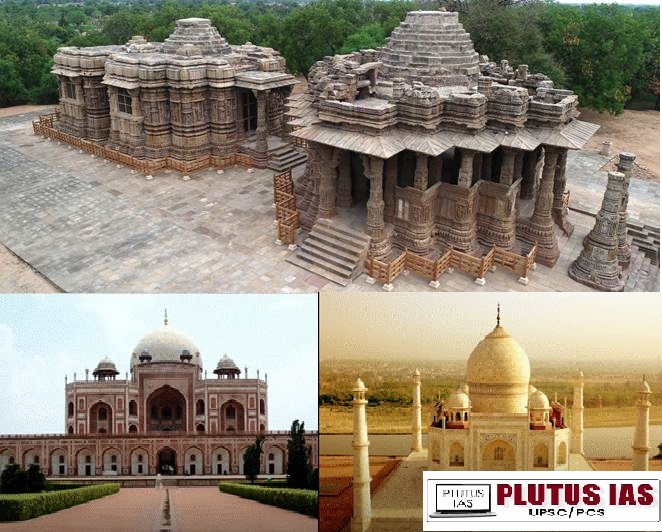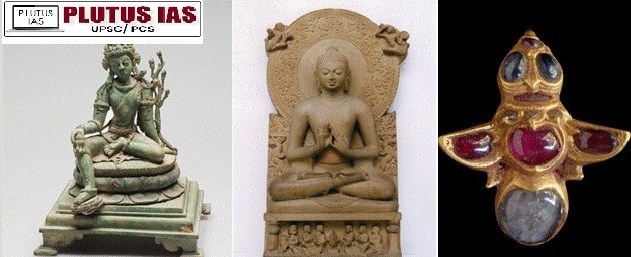20 Mar Digitization of Cultural Heritage in India
This article covers “Daily Current Affairs” and topic details of Digitization of Cultural Heritage in India
SYLLABUS MAPPING:
GS- 01- Indian Heritage and Culture:Digitization of Cultural Heritage in India.
FOR PRELIMS
What is NMMA, and there objectives. Important UNESCO World Heritage Site and their relevance.
FOR MAINS
Role of Digital Technology in Heritage Preservation. Achievement,Challenges of NMMA and there way Forward .
Why in the News?
The NMMA has recently gained attention due to its renewed focus on large-scale digitization projects, new collaborations with technology firms, and increased government funding for heritage preservation. The initiative has also been highlighted in discussions about India’s commitment to UNESCO’s heritage conservation goals. Furthermore, with rising concerns over climate change, urbanization, and illegal artifact trafficking, NMMA’s efforts to create a robust digital inventory have become more crucial than ever. Additionally, recent advancements in AI, blockchain, and 3D scanning have enabled NMMA to document and protect cultural assets more efficiently, making it a key player in modern heritage conservation efforts.

National Mission on Monuments & Antiquities (NMMA)
The National Mission on Monuments & Antiquities (NMMA) was launched in 2007 under the Ministry of Culture, Government of India, with the objective of documenting and preserving India’s vast cultural and historical heritage. This mission was conceived to address the critical need for a well-maintained record of movable and immovable antiquities, which would help safeguard the nation’s legacy for future generations.
Objectives of NMMA
The NMMA was established with a set of clear objectives:
1. Inventory Preparation: To create a national-level database of antiquities and monuments, ensuring their proper documentation. This database helps track ownership and prevent illicit trade in antiquities, making it easier to recover lost or stolen artifacts.
2. Protection & Conservation: To facilitate conservation efforts by identifying and assessing the condition of historical sites and artifacts. This includes recommending necessary interventions to prevent further degradation due to environmental and human-induced factors.
3. Regulation & Legal Framework: To strengthen the Antiquities and Art Treasures Act, 1972, and ensure that heritage sites are legally protected. NMMA works towards enforcing stricter penalties for illegal possession and trafficking of antiquities.
4. Awareness & Education: To educate the public, scholars, and stakeholders about the importance of cultural heritage preservation. Public awareness campaigns, exhibitions, and interactive sessions help foster a sense of pride and responsibility among citizens.
5. Digital Archiving: To use digital technology for the documentation and management of heritage sites, improving accessibility and reducing the risks of damage. Digital archives provide a valuable resource for researchers, enabling deeper insights into historical contexts.
6. Capacity Building & Training: NMMA organizes training programs and workshops for professionals in the heritage sector, equipping them with the necessary skills to document and conserve cultural assets efficiently.
7. Community Involvement: The mission promotes community participation by engaging local populations in conservation efforts. This approach helps protect heritage through grassroots initiatives and encourages a shared sense of ownership.
8. Integration with Smart Cities and Urban Planning: NMMA collaborates with urban planners to ensure that heritage conservation is considered in modern city planning. This integration helps in balancing development with heritage preservation.
Achievements of NMMA
Since its inception, NMMA has made significant progress in the documentation and preservation of India’s cultural heritage:
1. Database Development: Over 2.1 lakh (210,000) antiquities have been documented and uploaded into the national database. This extensive collection is available for research, aiding scholars in their studies on India’s rich historical past.
2. Mapping and GIS Integration: The integration of Geographic Information System (GIS) technology has helped in creating detailed maps of heritage sites. This allows authorities to monitor heritage sites remotely and plan conservation efforts more effectively.
3. Public Awareness Programs: Various workshops, seminars, and training programs have been conducted to involve local communities in heritage conservation. These programs emphasize the importance of community participation in preserving and protecting cultural heritage.
4. Collaboration with Institutions: NMMA has partnered with museums, research institutions, and universities to enhance the documentation and study of Indian antiquities. These collaborations provide expertise and resources for more extensive research and conservation projects.
5. Online Accessibility: Several digital platforms have been developed to provide public access to heritage-related data, promoting research and awareness. Online archives enable global scholars and historians to study and appreciate India’s cultural wealth.
6. Adoption of Emerging Technologies: NMMA has begun incorporating Artificial Intelligence (AI), 3D scanning, and blockchain technology to improve documentation and authentication processes, ensuring greater transparency in cultural heritage management.
7. International Recognition and Collaborations: The NMMA has received appreciation from UNESCO and other international bodies for its efforts in digitization and heritage preservation. It has also collaborated with foreign universities and research institutions to share best practices in heritage conservation.
8. Restoration Initiatives: Several heritage sites have been identified and restored as part of NMMA’s conservation efforts. This includes projects in historical cities such as Varanasi, Jaipur, and Hampi, where monuments have been restored to their original grandeur using scientific restoration techniques.
Role of Digital Technology in Heritage Preservation
Key Digital Technologies Used in Heritage Preservation:
1. 3D Scanning and Modeling: This technology enables the creation of digital replicas of monuments and artifacts, preserving their intricate details. It allows conservationists to analyze structures without causing physical damage and provides a reference for restoration projects.
2. Artificial Intelligence (AI) and Machine Learning (ML): AI helps in the identification, classification, and restoration of antiquities through automated image recognition. AI-driven algorithms can also predict potential risks to heritage sites based on historical trends and current environmental conditions.
3. Virtual Reality (VR) and Augmented Reality (AR): These technologies allow people to experience historical sites and artifacts in a virtual environment, making heritage more accessible. Virtual reconstructions of ancient sites provide an immersive learning experience for students and history enthusiasts.
4. Blockchain for Provenance Tracking: Ensures the authenticity and ownership history of artifacts, preventing illegal trade and theft. This technology enhances transparency in the art market and helps governments reclaim stolen cultural assets.
5. GIS Mapping and Remote Sensing: Helps in the accurate documentation and monitoring of heritage sites, assessing environmental and human-induced threats. Authorities can use this data to develop better conservation strategies and disaster preparedness plans.
6. Big Data and Cloud Storage: Enables the secure storage and analysis of vast amounts of heritage-related data for research and policymaking. This ensures that valuable information remains accessible even in cases of physical loss or damage.

Challenges in Heritage Preservation
Despite the advancements in digital technology, there are several challenges that hinder effective heritage preservation:
1. Lack of Infrastructure: Many heritage sites lack the necessary technological infrastructure for digital documentation and conservation. Rural and remote heritage sites require significant investments in digital connectivity and technical equipment.
2. Financial Constraints: Insufficient funding restricts the implementation of large-scale digitization projects. Limited government budgets often result in delayed or incomplete conservation efforts.
3. Skilled Manpower Shortage: A lack of trained professionals in heritage conservation and digital technologies poses a significant challenge. More training programs and academic courses are needed to build a skilled workforce.
4. Legal and Policy Issues: Inadequate enforcement of heritage protection laws leads to encroachments, illegal trade, and loss of artifacts. Strengthening regulations and ensuring accountability among stakeholders is crucial.
5. Climate Change and Environmental Factors: Rising pollution, natural disasters, and changing climate conditions threaten the structural integrity of monuments and artifacts. Advanced monitoring systems must be implemented to mitigate environmental risks.
6. Limited Public Awareness and Participation: Heritage conservation efforts require active participation from local communities, which is often lacking. More initiatives should be taken to involve people in protecting their cultural legacy.
7. Cybersecurity Risks: Digital databases containing sensitive heritage information are vulnerable to hacking and cyber threats. Robust cybersecurity measures must be implemented to safeguard valuable digital records.
Way Forward
To overcome these challenges and enhance heritage preservation efforts, India must adopt a multi-pronged approach:
1. Strengthening Digital Infrastructure: Investment in modern digital tools, cloud storage, and AI-driven applications will enhance preservation efforts. Expanding internet access to rural heritage sites will also help in efficient documentation.
2. Public-Private Partnerships (PPP): Collaboration between the government, private sector, and NGOs can help in securing funds and expertise for digitization projects. Private organizations can bring in technological innovations and financial support.
3. Capacity Building & Training: Developing training programs for historians, archaeologists, and tech professionals to bridge the skill gap. Universities should introduce specialized courses on digital heritage preservation.
4. Policy Reforms & Strict Enforcement: Strengthening laws related to heritage protection and ensuring their proper implementation. The government should impose stricter penalties for heritage-related crimes.
5. International Collaboration: Partnering with global institutions and leveraging best practices in digital heritage preservation. Cross-border partnerships can facilitate knowledge exchange and access to advanced technologies.
6. Increased Community Engagement: Raising awareness through educational programs and involving local communities in conservation initiatives. Encouraging heritage tourism can create economic incentives for local communities to protect cultural sites.
7. Developing Sustainable Preservation Strategies: Using eco-friendly materials and conservation methods to mitigate environmental risks. Green technologies should be incorporated in heritage site management.
Conclusion
The digitization of cultural heritage in India is not just a technological advancement but a necessity to preserve the country’s rich history for future generations. The National Mission on Monuments & Antiquities (NMMA) has played a vital role in this endeavor by documenting and safeguarding valuable heritage assets. With the integration of cutting-edge technologies such as AI, 3D scanning, and blockchain, India is making significant strides in modernizing heritage conservation. However, continuous efforts are needed to enhance public engagement, improve data accessibility, and foster collaborations between governmental and non-governmental organizations. As India moves forward, a comprehensive and sustainable approach will be crucial to ensuring that its cultural wealth remains protected and accessible for generations to come. of cultural heritage in India is not just a technological advancement but a necessity to preserve the country’s rich history for future generations. The National Mission on Monuments & Antiquities (NMMA) has played a vital role in this endeavor by documenting and safeguarding valuable heritage assets.
Download Plutus IAS Current Affairs (Eng) 20th March 2025
PRELIMS Questions:
Q.Which act provides a legal framework for the protection of Indian antiquities?
a) The Indian Treasure Act, 1878
b) The Antiquities and Art Treasures Act, 1972
c) The Monuments Protection Act, 1958
d) The Cultural Heritage Conservation Act, 2005
ANSWER: B
MAINS Questions:
(250 words, 15 marks)




No Comments